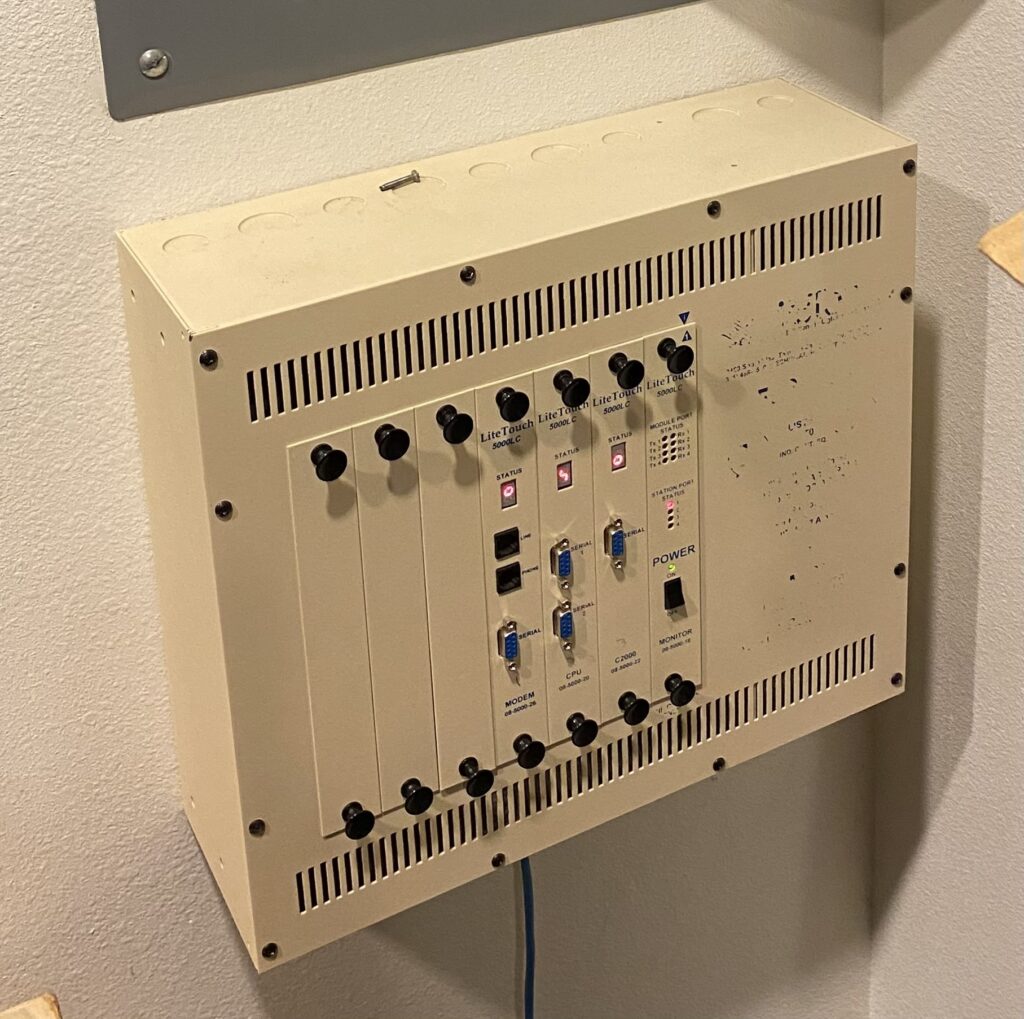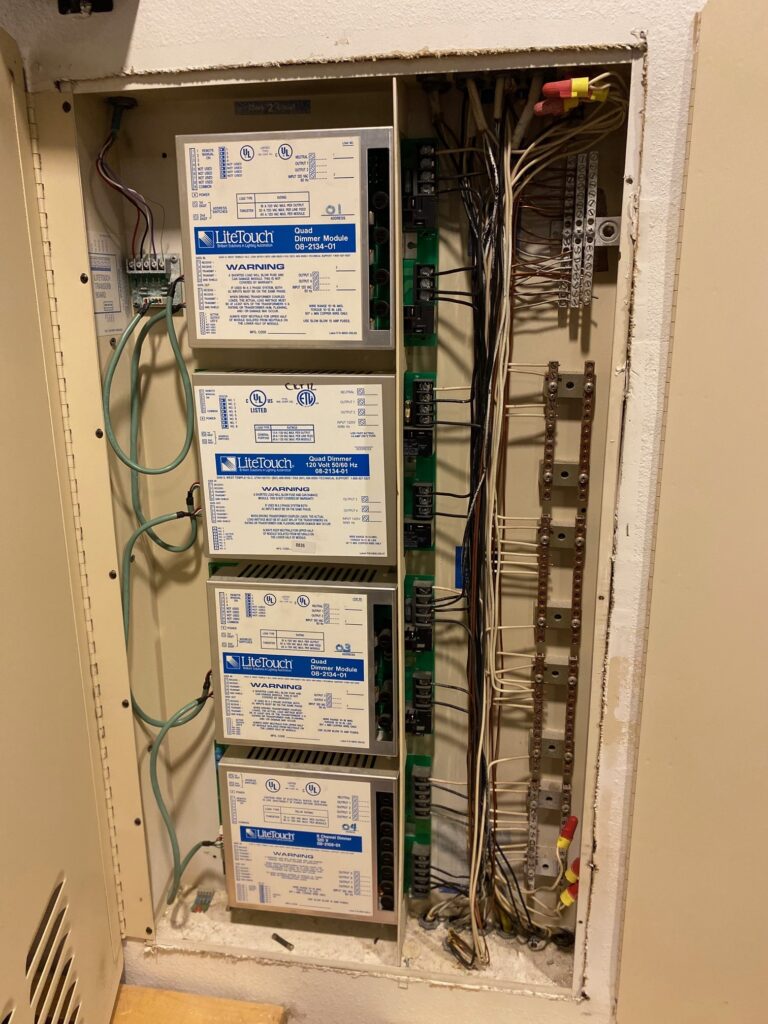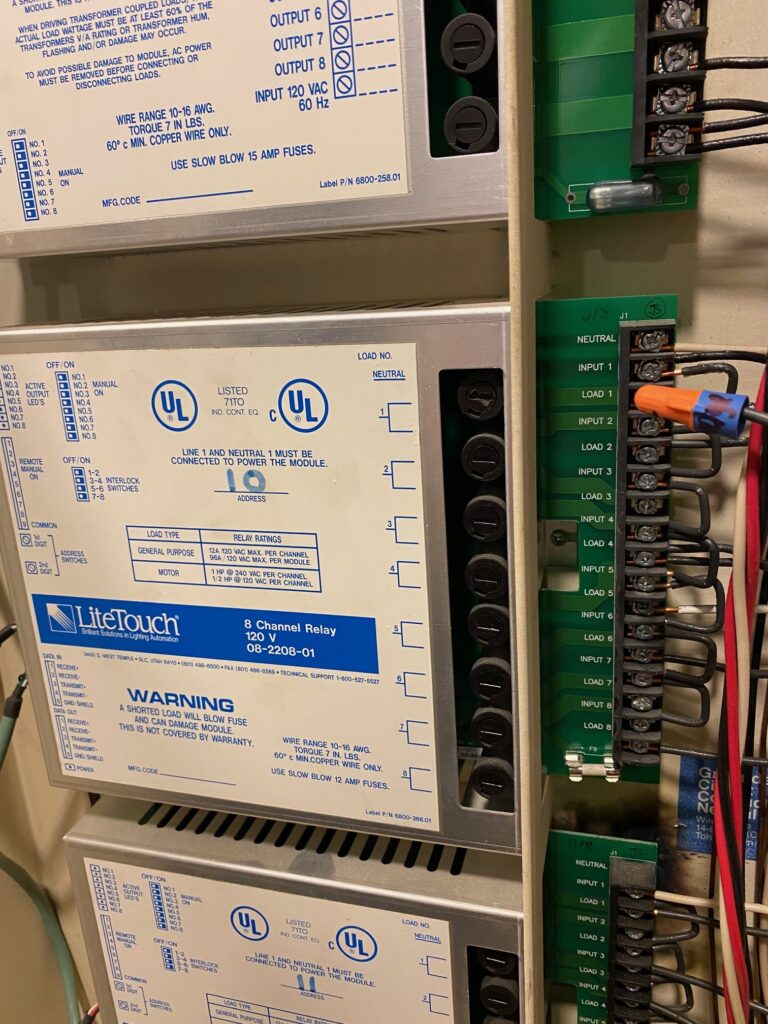The Evolution and Influence of LiteTouch Lighting in Lighting Technology
LiteTouch, founded in 1978, carved a niche for itself in the custom lighting control sector. Its inception marked a significant shift in how homeowners and businesses approached lighting solutions. Over the years, LiteTouch lighting systems became synonymous with luxury, offering advanced solutions for both residential and commercial properties. These systems, often considered premium, ranged in costs from $25,000 to several hundred thousand dollars, reflecting their advanced capabilities and the value they added to properties.

Why Replace LiteTouch?
With the rise of competitors such as Loxone, Lutron, Vantage and Savant, LiteTouch faced challenges in maintaining its dominant position. The landscape of the lighting industry was rapidly changing, and LiteTouch had to adapt. However, in a surprising turn of events, Savant acquired LiteTouch in 2012. By 2015, Savant made the decision to discontinue the LiteTouch line. This left many dedicated users without manufacturer support, leading to a pressing question: What next?
The inherent risks of continuing with an antiquated LiteTouch lighting control system have become increasingly clear. As technology advances and the demands of modern living evolve, the limitations and vulnerabilities of older systems come to the forefront. This has underscored the urgency for users to explore and transition to more contemporary and reliable alternatives.

The Risks of Using Outdated LiteTouch Lighting Control Systems
System Failures
As with any technology, the components of LiteTouch lighting systems have a finite lifespan. Over time, these components can degrade, leading to system failures. Such failures can range from minor inconveniences, like a single light not working, to major issues, such as the entire system becoming non-responsive. Without timely updates and maintenance, these failures can become frequent and disruptive.
Lack of Replacement Parts
Given that LiteTouch lighting systems have been discontinued, finding replacement parts has become a significant challenge. Even if homeowners manage to source parts, they often come at a premium due to their scarcity. This can make even minor repairs expensive and time-consuming.
Absence of Technical Support
With the discontinuation of LiteTouch, official technical support is no longer available. This leaves homeowners reliant on third-party technicians, who might not have the specific expertise required for LiteTouch systems. Without proper support, troubleshooting and resolving issues can become a daunting task.
Incompatibility with Modern Technology
As the world of smart home technology rapidly advances, outdated systems like LiteTouch risk becoming incompatible with newer devices and technologies. This can hinder homeowners from integrating their lighting systems with other smart home devices, limiting the potential benefits of a connected home.
Decreased Property Value
For homeowners considering selling their property, an outdated and potentially malfunctioning lighting system can be a deterrent for potential buyers. Modern homebuyers often seek properties equipped with the latest technologies, and an old LiteTouch system might negatively impact the property’s appeal and value.
The Benefits of Modern LiteTouch Lighting Automation and Smart Home Systems.
Lighting control has evolved significantly since the days of LiteTouch. Homeowners now have the luxury of controlling their lighting systems using smartphones, setting automated schedules, and even integrating them with other smart home devices. Pathway lighting, emergency lighting, and energy cost reductions are just a few of the myriad benefits offered by contemporary lighting control systems. The concept of lighting automation has truly transformed the way we perceive and interact with our living spaces.
Energy Efficiency
Modern lighting automation systems are designed with energy conservation in mind. They can adjust the brightness based on the time of day or occupancy, ensuring that no energy is wasted. This not only reduces electricity bills but also contributes to a greener environment.
Enhanced Security
With features like motion sensors and automated pathway lighting, modern systems ensure that your property is well-lit when needed, deterring potential intruders. Additionally, in the event of a security breach, lights can be programmed to flash, drawing attention and potentially scaring off intruders.
Convenience at Your Fingertips
Gone are the days of manually adjusting each light. With smart home integrations, you can control your entire lighting system through a smartphone or voice commands. Whether you’re in bed and forgot to turn off the kitchen lights or on vacation and want to simulate occupancy, it’s all possible with a few taps.
Customized Ambiance
Modern systems allow homeowners to set scenes. Planning a romantic dinner? Choose a preset that dims the lights just right. Hosting a movie night? Select a scene that provides optimal lighting for a home theater experience.
Integration with Other Smart Devices
Lighting systems today can communicate with other smart devices in your home. Imagine your lights gradually turning on as your smart thermostat detects you’re waking up, or flashing when your smart doorbell rings. The possibilities are endless.
Extended Lifespan of Bulbs
Dimming capabilities mean that bulbs often operate at less than maximum power, extending their lifespan. Over time, this results in significant savings, both in terms of bulb replacements and energy consumption.
Health and Well-being
Research indicates that lighting can impact our mood and circadian rhythms. Modern lighting systems can simulate natural light patterns, potentially improving sleep quality and overall well-being.
Loxone: The New Age LiteTouch Replacement
Loxone, a global leader in the automation industry with over 150,000 installations worldwide, has emerged as a replacement system for a LiteTouch system. Here’s a deep dive into its technical prowess and how it stands out:
Reliability and Performance
Miniserver Excellence: The Miniserver, often referred to as the brain of the Loxone system, boasts an impressive track record. Since its inception, not a single Miniserver has reportedly gone down due to internal hardware or Loxone software issues. This speaks volumes about its reliability.
Expandability and Integration
Extensions Galore: LiteTouch operated on a module-based model to expand automation capabilities. Loxone mirrors this approach with its extensions. However, Loxone’s extensions offer more versatility and integration. From wireless communication via the Air Base Extension to DALI light control, the list of Loxone extensions is ever-growing. This ensures that homeowners can easily adapt and expand their automation system as their needs evolve.
Advanced Lighting Control
LED Mastery: While LiteTouch was renowned for its advanced lighting control, Loxone takes it a step further, especially with LEDs. LEDs, known for their longevity and energy efficiency, are now predominantly used in homes. Loxone’s prowess in controlling LEDs, including advanced RGBW LED control, allows homeowners to adjust light colors instantly using the Loxone app. This facilitates the creation of ambient lighting scenes tailored to different moods and times of the day.
User-Friendly App
Loxone App: Modern automation systems are incomplete without a dedicated app. Loxone’s app stands out due to two major features:
Local Processing: All automation commands are processed on a local network. This ensures that even if the internet is down, as long as Wi-Fi is operational, the app functions seamlessly.
Automatic Designer: This feature simplifies the customization of home automation plans. Whether it’s adjusting light brightness based on the time of day or setting specific schedules, homeowners can do it all without needing an integrator.
Aesthetic and Functional Keypads
Minimalist Design: Loxone’s award-winning Touch Pure switches are a testament to minimalist design. Unlike the utilitarian design of LiteTouch keypads, Loxone’s switches are sleek and multifunctional. They can control lighting, music, and blinds, reducing the number of switches on walls. Additionally, these switches come with built-in temperature and humidity sensors, paving the way for individual room climate control without separate thermostats.
Configurability
Loxone Config: While LiteTouch had LiteWare for programming, Loxone offers Loxone Config. This software, available to the public, allows homeowners to program their automation system. It might have a learning curve, but once mastered, it grants complete autonomy over the automation system. For those apprehensive about programming, the Automatic Designer in the app offers a simpler alternative.
Benefits of Replacing LiteTouch with Loxone
Loxone, a name that has been gaining traction in the smart home industry, presents itself as a viable replacement for the now-defunct LiteTouch systems. But what makes Loxone stand out? Let’s delve into the benefits of the Loxone lighting system:
Comprehensive Energy Management
At the heart of Loxone’s offerings is its commitment to energy efficiency. The brand’s energy management system, paired with the Loxone App, empowers homeowners to actively monitor and reduce their energy consumption. By incorporating LED lights into their product lineup, Loxone ensures that users not only enjoy optimal lighting but also benefit from reduced energy bills and a smaller carbon footprint.
All-in-One Lighting Solutions
Loxone’s Ceiling Light is more than just a light source. It’s an embodiment of the brand’s vision for integrated smart home solutions. With an in-built motion sensor, this lighting solution can adapt to the occupants’ movements, ensuring optimal lighting conditions at all times.
Unique Lighting Characteristics
Diversity in lighting is crucial for setting the right mood, and Loxone understands this. Products like their LED Pendulum Slim offer homeowners the flexibility to choose between soft, diffused color lighting or a more focused, warm white illumination.
Seamless Integration with Other Systems
One of Loxone’s standout features is its ability to seamlessly integrate its lighting solutions with other smart home systems. Whether it’s sound, shading, heating, or cooling, Loxone ensures that all systems communicate effectively, providing users with an unparalleled smart home experience.
User-Friendly Control
Ease of use is at the core of Loxone’s design philosophy. Their smart lighting control systems are intuitive, allowing even those new to smart homes to effortlessly customize and control their lighting preferences.
Expert Recommendation
For homeowners with a pre-existing LiteTouch setup or those considering a new home automation system, Loxone emerges as a modern-day frontrunner. With its Miniserver at the core and a plethora of extensions, it offers unparalleled adaptability. The Loxone app, with its local processing, ensures uninterrupted control even in internet downtimes. It’s recommended to explore Loxone’s offerings, especially if advanced LED control and minimalist design are priorities.

Step-by-Step Guide to Replacing LiteTouch
Step 1: Evaluation and Documentation
Assess the Current System: Begin by evaluating the existing LiteTouch system. Identify the number of circuits, types of loads (e.g., dimmable, non-dimmable), and any custom configurations.
Document Everything: Make a detailed list of all components, their locations, and their functionalities. This documentation will be invaluable during the replacement process.
Step 2: Identify Reusable Components
Inspect Hardware: Check the condition of keypads, control modules, and other hardware components. While some might still be functional, newer systems might require updated versions for optimal performance.
Check Wiring and Enclosures: Some of the existing wiring and enclosures might be reusable, saving on costs and installation time.
Step 3: Choose the Right Replacement
Research Options: Dive deep into the offerings of brands like Loxone, Lutron, and Savant. Understand their features, compatibility, and user reviews.
Consult a Professional: Engage with a lighting control expert, such as SmartSpace Automation, to get recommendations tailored to your specific needs and preferences.
Step 4: Procure the Necessary Components
Purchase New Hardware: Based on your research and consultation, buy the necessary components for the new system.
Software Solutions: Ensure you have access to the latest software platforms required for configuration and control.
Step 5: Begin the Installation Process
Turn Off the Power: Before starting any work, ensure the power to the LiteTouch system is turned off for safety.
Remove Old Components: Carefully uninstall outdated or non-functional components from the LiteTouch system.
Install New Hardware: Follow the manufacturer’s guidelines to install new keypads, control modules, and other hardware.
Test Each Component: As you install, test each component to ensure it’s functioning correctly.
Step 6: Software Configuration
Install Necessary Software: Download and install the software platforms associated with your new system.
Configure Settings: Set up lighting scenes, schedules, and preferences using the software. Ensure all components are recognized and functioning within the software environment.
Step 7: Final Testing and Troubleshooting
Test the Entire System: Once everything is set up, test the entire system to ensure all components work harmoniously.
Address Any Issues: If you encounter any problems, refer to the manufacturer’s troubleshooting guides or consult with a professional.
Step 8: User Training
Familiarize Yourself: Spend time getting to know the new system, its features, and its controls.
Seek Expert Guidance: If the system offers advanced features, consider a training session with a professional to maximize the benefits of your new lighting control system.
The discontinuation of the LiteTouch system has left many homeowners in search of a reliable and modern replacement. While several brands like Loxone, Lutron, Savant, and Vantage have stepped up to fill the void, the choice ultimately depends on individual preferences, requirements, and budget. Each system offers its unique set of features, benefits, and potential drawbacks. It’s essential to thoroughly research and possibly consult with experts before making a decision. Regardless of the choice, transitioning to a new system promises enhanced functionality, energy efficiency, and a seamless smart home experience
Need expert guidance on choosing the right lighting control system? Contact our team at SmartSpace Automation for personalized advice and solutions tailored to your needs.
FAQs
-
1. What happened to LiteTouch lighting systems?
LiteTouch lighting systems were discontinued in 2015, and both support and replacement parts for these systems are no longer available.
-
2. Why should homeowners consider replacing their LiteTouch system?
With the discontinuation of support and replacement parts, there’s a risk of the hardware completely failing. Additionally, by today’s standards, LiteTouch systems may not match the capabilities of modern lighting control and smart home functionalities.
-
3. Can the existing wiring structure of a LiteTouch system be reused for a new lighting system?
Yes, certain modern lighting systems allow for the reuse of the existing wiring structure, making the transition smoother.
-
4. How do modern lighting control systems compare to LiteTouch in terms of functionality?
Modern systems often offer enhanced smart home functionalities, better integration with other home automation devices, and are more in line with today’s technological standards.
-
5. Is it cost-effective to transition from a LiteTouch system to a modern lighting control system?
While there might be initial costs involved in transitioning, the benefits of having a modern, supported system with advanced features can offer long-term value and peace of mind.

